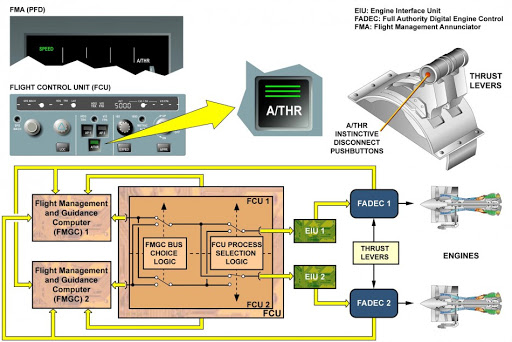To add one piece of information to Jan's answer, quoting from the A320 Flight Crew Training Manual, a detailed description of what exactly is autothrust:
OBJECTIVE
The A/THR computer (within the FG) interfaces directly with the engine computer, referred to as the FADEC. The A/THR sends to
the FADEC the thrust targets that are needed to:
• Obtain and maintain a target speed, when in SPEED mode
• Obtain a specific thrust setting (e.g. CLB, IDLE), when in THRUST
mode.
INTERFACE
When the A/THR is active, the thrust lever position determines the maximum thrust that the A/THR can command in SPEED or
THRUST mode. Therefore, with A/THR active, thrust levers act as a
thrust limiter or a thrust-rating panel. The A/THR computer does not
drive back the thrust levers. The PF sets them to a specific detent on
the thrust lever range.
The A/THR system provides cues that indicate the energy of the
aircraft:
• Speed, acceleration, or deceleration, obtained by the speed trend
vector
• N1, and N1 command on the N1 gauge.
All these cues are in the flight crew’s direct line of vision. In
other words, the Thrust Lever Angle (TLA) should not be used to
monitor correct A/THR operation. Neither should the thrust lever
position of a conventional autothrottle, be considered a cue because,
in many hazardous situations, the thrust lever position can be
misleading (e.g. engine failure, thrust lever jammed).

The A/THR can only be active, when the thrust levers are between IDLE
and the CLB detent.
When the thrust levers are beyond the CLB detent,
thrust is controlled manually to the thrust lever Angle, and the A/THR
is armed . This means that the A/THR is ready to be re-activated, when
the flight crew sets the thrust levers back to the CLB detent (or
below).A/THR appears in blue on the FMA.

In addition:
If thrust levers are set to IDLE, A/THR is set to off.
and:
AP, FD, A/THR SYSTEM INTEGRATION
There is a direct relationship between aircraft pitch control, and engine thrust control. This
relationship is designed to manage the aircraft’s energy.
• If the AP/FD pitch mode controls a vertical trajectory (e.g. ALT,
V/S, FPA, G/S): A/THR controls speed
• If the AP/FD pitch mode
controls a speed (e.g. OP CLB, OP DES): A/THR controls thrust (THR
CLB, THR IDLE)
• If no AP/FD pitch mode is engaged (i.e. AP is off and
FD is off): A/THR controls speed
Therefore, any change in the AP/FD pitch mode is associated with a
change in the A/THR mode.
On the other hand, manual thrust is a conventional and proportional interpretation of the position of the TLP: 0% throttle at IDLE, 100% at TOGA and linearly interpolated inbetween.
As for why the A/THR is seldomly not used, from the same manual (emphasis mine):
Use of A/THR is recommended during the entire flight.
It may be used in most failures cases, including:
• Engine failure, even during autoland
• Abnormal configurations



